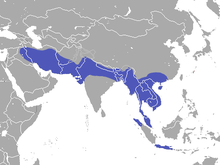Little mongoose
| Little mongoose | ||||||||||||
|---|---|---|---|---|---|---|---|---|---|---|---|---|

Little Mongoose ( Herpestes javanicus ) |
||||||||||||
| Systematics | ||||||||||||
|
||||||||||||
| Scientific name | ||||||||||||
| Herpestes javanicus | ||||||||||||
| ( É. Geoffroy , 1818) |
The small mongoose ( Herpestes javanicus ) is a species of predator from the mongoose family (Herpestidae). When the "mongoose" is spoken of in general, either this species or the Indian mongoose are mentioned.
The synonymous terms Herpestes palustris and Herpestes auropunctatus can also be found in the scientific literature .
features
Small mongooses have a head body length of 25 to 41 centimeters, plus 23 to 50 centimeters of tail. Their weight varies between 0.4 and 0.6 kilograms, with the males being slightly heavier than the females. Your body is elongated and slender, the limbs are relatively short. The color of the fur varies from grayish to golden brown and is slightly lighter on the underside.
distribution and habitat
The natural range of the little mongooses extends from Pakistan through northern India and southern China to Southeast Asia (the Malay Peninsula and the islands of Sumatra , Borneo and Java ). For reasons of pest control, they were introduced in numerous regions, including numerous Caribbean islands , northern South America , Pacific islands such as Hawaii and Fiji and, since 1910, on several Croatian islands and now some Balkan states.
Small mongooses inhabit a range of habitats, including tropical rainforests and other forest types, but also open landscapes such as grasslands.
Way of life
Small mongooses are diurnal animals that usually live as solitary animals, but sometimes stay together as loose family groups. During the day they leave their caves and look for food. This consists mainly of insects, but also of various vertebrates such as small mammals, birds, lizards and snakes, but also of scorpions and other invertebrates and fruits. Since mongooses can move at lightning speed, they also attack poisonous snakes, whose attacks they then evade quickly. These snake fights have become famous, but they are not immune to snake venom. They let the snake hit again and again, dodging each time, and ultimately the snake is so tired that it can be easily killed. If a mongoose is bitten in such a fight, the snake with its short fangs often does not penetrate its thick, bushy fur.
After a gestation period of around 50 days, the female gives birth to two to five young animals. These are weaned after four to five weeks and are sexually mature at one year.
Endangerment and Invasive Species
The little mongoose is common in its traditional range and is not an endangered species. The International Union for Conservation of Nature ( IUCN) also lists it in the Red List of Threatened Species as “Least Concern”.
The little mongoose was, however, abducted by humans to numerous areas of the world where it was not originally found. It was hoped that this would help fight the plague of rats. However, the move created much more serious problems as the mongooses endangered or even wiped out native wildlife in the new areas, broke into hen coops, forged food from humans and transmitted rabies and other diseases. The Global Invasive Species Database places it among the hundred most harmful invasive neobiota worldwide . Therefore, the little mongoose is being exterminated in some areas for nature conservation reasons.
The lesser mongoose has been added to the list of invasive alien species of Union concern .
See also
Since there is often no distinction between the two mongoose species, cultural references can be found under mongoose .
Individual evidence
- ↑ Herpestes javanicus - Small mongoose. Retrieved January 21, 2019 .
- ↑ 100 of the World's Worst Invasive Alien Species . Global Invasive Species Database. Retrieved March 30, 2011.
- ↑ A. Barun, CC Hanson, K J. Campbell, D. Simberloff: A review of small Indian mongoose management and eradications on islands . In: CR Veitch, MN Clout, DR Towns (Ed.): Island invasives: eradication and management . IUCN, Gland (CH) 2011, p. 17–25 ( article, pdf , issg.org).
- ↑ List of Invasive Alien Species of Union Concern (PDF) accessed on July 15, 2016
literature
- Ronald M. Nowak: Walker's Mammals of the World . Johns Hopkins University Press, 1999 ISBN 0-8018-5789-9
Web links
- Illustration and further information
- Herpestes javanicus in the endangered Red List species the IUCN 2009. Posted by: Wozencraft, C. Duckworth, JW, Choudury, A., Muddapa, D., Yonzon, P., Kanchanasaka, B. Jennings A. & Veron, G., 2008. Retrieved January 26, 2010.
